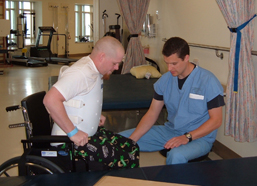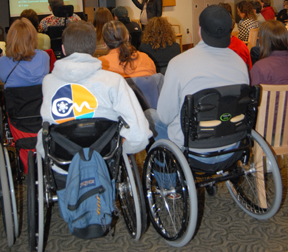Hydrophilic catheters for prevention of UTIs: A randomized clinical trial in chronic SCI
Diana D. Cardenas, MD, MHA, and Jeanne Hoffman, PhD
The Northwest Regional Spinal Cord Injury System receives funding from NIDRR (National Institute on Disability and Rehabilitation Research) to conduct research in different areas of SCI diagnosis and treatment. This study was conducted during the most recent 2000-2005 funding cycle.
Urinary tract infections (UTIs) in SCI
In spite of improvements in bladder management methods over the years, urinary tract infections (UTIs) continue to be a significant problem in the SCI population and the most frequent cause of rehospitalization for all neurologic levels, said Dr. Diana D. Cardenas, who recently left the UW as professor of rehabilitation medicine and director of the Northwest Regional Spinal Cord Injury System. Reports from the Model SCI System indicate that 56.6% of patients acquire a UTI between discharge and one year follow-up, and 28% - 37% are hospitalized for these problems for an average of 14 days.1,2
For these reasons, “prevention of UTI remains a primary goal of neurogenic bladder management in SCI” said Cardenas. “Intermittent catheterization (IC) has become the standard of care, particularly if there is adequate manual dexterity to do self-IC, because evidence shows there is less chance of UTIs, less damage to the urethra, and decreased risk of bladder stones, bladder cancer and fistulas than using an indwelling catheter.”
IC techniques and equipment varies widely and new catheter systems are continually being developed to try to reduce the frequency of UTIs. The hydrophilic catheter is a relatively new product designed to reduce friction. Its features include:
- An outer layer of a hydrophilic compound called polyvinylpyrrolidone that binds with water to create a liquid surface that reduces friction.
- A thin film of water glides along the urethra with less friction than an ordinary catheter with lubricant.
- Uses ordinary tap water ( some newer systems already have water in the packaging).
“The rationale behind this catheter is that less friction causes less urethral tissue trauma, which may reduce the chances of invasion by UTI-causing bacteria,” Cardenas explained. “Hence, the hydrophilic catheter may help reduce incidence of UTIs.”
Study objectives and methods
To test this proposition, Cardenas conducted a randomized controlled trial of the Lofric hydrophilic catheter versus standard catheters in chronic (long-standing) SCI patients who have recurrent symptomatic UTIs. Subjects randomly assigned to the control group continued to use their usual catheters, and the treatment group used the LoFric hydrophilic catheter. Urine was collected and tested for bacteria on each subject monthly for the first three months, then every three months up to one year, as well as any time there were symptoms of UTI. Subjects periodically completed a UTI Symptom Inventory and a bladder management questionnaire.
Findings
Forty-four subjects completed the study, with 21 randomly assigned to the treatment group and 23 to the control group. Using as the main outcome measure the number of times a subject was treated for UTI with antibiotics, Cardenas found that there were significantly fewer antibiotic treatment episodes (.86) in subjects using the hydrophilic catheter than in controls (1.69). She also found that this difference disappeared when looking at females only.
Cardenas concluded, “Hydrophilic catheter use for self-IC was associated with reduced numbers of treated UTIs compared to standard non-hydrophilic catheters. And women on self-IC were more likely to develop UTIs regardless of the catheter type, suggesting that the benefits of the lubrication may be more important in males.” Cardenas recommends that further research on hydrophilic catheters be conducted with larger numbers of women and with catheters designed for women.
References
1M. DeVivo, G.G. Whiteneck and E.D. Charles, The economic impact of spinal cord injury. In: S.L. Stover, J.A. DeLisa and G.G. Whiteneck, Editors, Spinal cord injury: clinical outcomes from the model systems, Aspen, Gaithersburg (1995), pp. 234-271.
2Cardenas DD, Hoffman JM, Kirshblum S, McKinley W. Etiology and incidence of rehospitalization after traumatic spinal cord injury: a multicenter analysis. Arch Phys Med Rehabil. 2004 Nov;85(11):1757-63.






